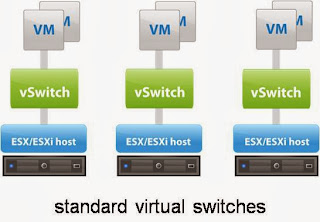In simple terms, vSphere Standard Switches need to be created on each individual hosts. For example, If you have 2 ESXi host in the cluster, All the port groups (for example Management, vMotion, Test environment and Production) needs to be created same as exact name on both the ESXi hosts for the vMotion to work between the ESXi hosts in the cluster.
vSphere Distributed Switch (vDS) provides centralized management and monitoring of the network configuration of all the ESXi hosts that are associated with the dvswitch. Distributed switch can be created and configured at vCenter server system level and all its settings are propagated to all the hosts that are associated with the switch. dvSwitch is designed to create a consistent switch configuration across every hosts in the datacenter. Network configuration and management for all the hosts that associated with the switch can be performed centralized on the vCenter server system. vDS is only available as part of vSphere Enterprise plus licensing and it’s not created by default.The dvswitch consists of two components, the control plane and the I/O or data plane. vSphere Distributed Switch is also referred as vDS (vSphere Distributed Switch and dvs (Distributed virtual switch).
The Control plane
Control plane exists at vCenter server and It is responsible for managing and configuring the dvswitch dvport groups,dvports, uplinks,VLANs,PVLANs and NIC teaming,etc. dvswitch is nothing but a configuration template used to configure the settings on each host which are connected to the dvswitch.
The Data Plane (I/O plane)
Data plane is hidden switch that exists on each host and it is responsible for forwarding the data packets to the relevant uplinks. Because of this data plane (hidden switch created at each host) network communication continues to work even if your vCenter is down.
